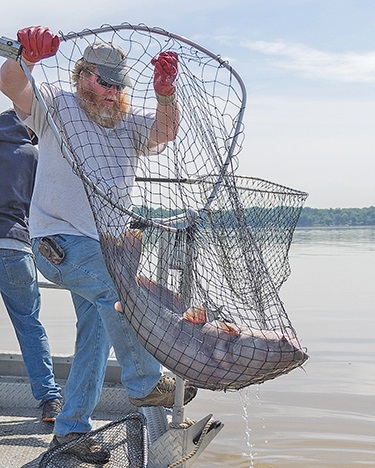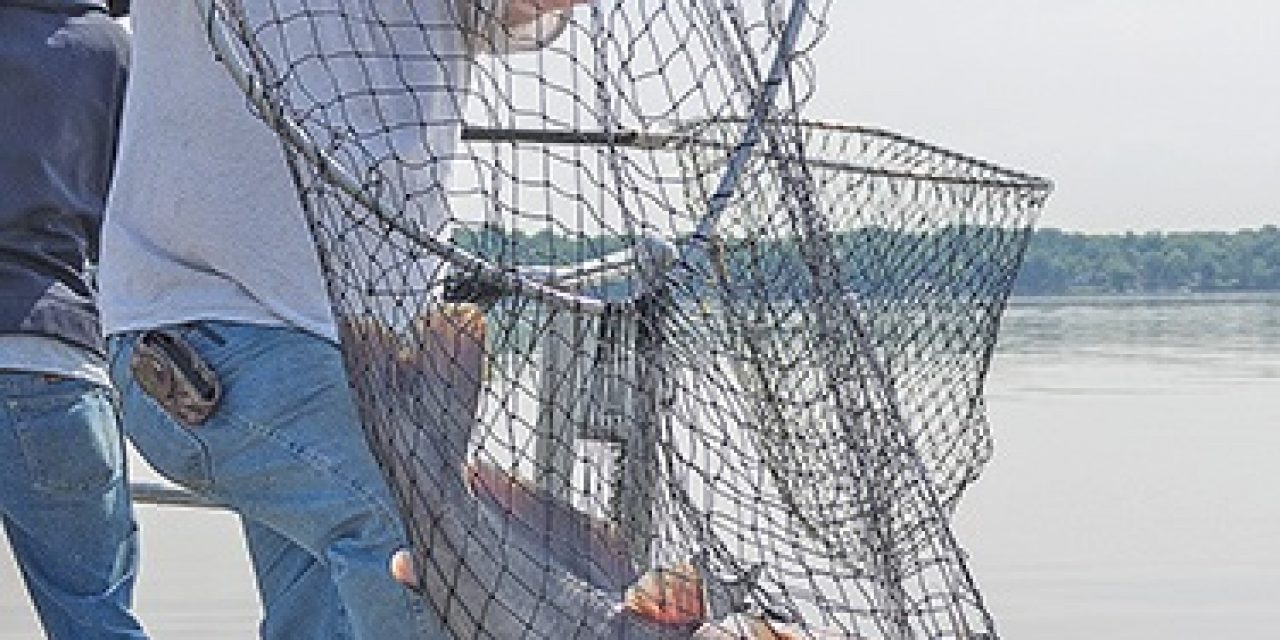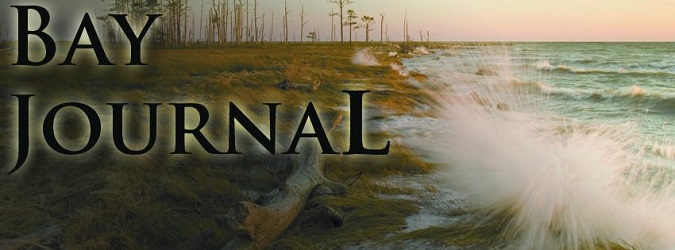 Last year’s record-setting rainfall brought more into the Chesapeake Bay than pollution and debris. Biologists say the freshwater deluge helped the nonnative blue catfish, which was already invading the estuary, to spread farther in the region’s rivers.
Last year’s record-setting rainfall brought more into the Chesapeake Bay than pollution and debris. Biologists say the freshwater deluge helped the nonnative blue catfish, which was already invading the estuary, to spread farther in the region’s rivers.
“The gate is open,” said Martin Gary, executive director of the Potomac River Fisheries Commission. “They have left and dispersed everywhere.”
Blue catfish, which can grow to lengths of 5 feet, were released into Virginia’s Bay tributaries in the 1970s as part of an effort to build a sport fishery.
Since then, they have reached numbers beyond what anyone imagined in rivers from the James to the Potomac, and they had begun spreading to other places in recent years. Biologists and state fishery managers had hoped to stem further expansion, fearing harm to native species such as blue crabs, yellow perch and white catfish.
Those hopes were washed away with 2018’s persistent rain. Blue catfish prefer fresh or slightly salty water, which somewhat constrains their movement into lower reaches of tidal rivers and the Bay itself. The heavy rain dramatically reduced salinities in rivers and most of the Bay, allowing the catfish to spread almost everywhere.
On the Potomac, blue catfish are generally found north of the Route 301 bridge. But last year, they spread throughout the lower river and beyond. A Baywide fish survey, which had never before found catfish in the mainstem of the Chesapeake, caught dozens off the mouth of the Potomac last fall.
Virginia biologists were surprised when the fish turned up in small creeks on the lower Eastern Shore — an area they thought might be safe from the invaders because of its normally high salinity.
“With all of the rain we’ve had, we are starting to see reports of blue catfish in a lot of areas that have never seen them before,” said Patrick Geer, deputy chief of the fishery management division of the Virginia Marine Resources Commission.
With the door open to new habitats, biologists say that blue catfish numbers will likely grow for the foreseeable future and are uncertain that much can be done about it. Virginia is poised to allow electrofishing by commercial harvesters to ramp up removals. But “whether or not we can curb the population, I don’t know for sure,” Geer said.
Most agree on one thing. Blue catfish are here to stay. What that means for the Bay, no one knows.
Too much success?
Depending on one’s perspective, the blue catfish may or may not be a success story. A native of the Mississippi River and the Texas Gulf Coast, it is the largest catfish species in North America.
It can live for more than two decades and reach monster sizes of more than 100 pounds, making it popular not only in its native range but for anglers and fish managers looking to import new species.
That’s what happened in the 1970s, when the Virginia Department of Game and Inland Fisheries began placing hundreds of thousands of them into Bay tributaries, primarily the Rappahannock and James rivers, to build a new sport fishery.
Though frowned on today, such introductions were once common. In this region, it led to the introduction of species such as channel catfish, smallmouth bass and brown trout.
For nearly two decades, blue catfish persisted without much notice. But in the mid-1990s, their numbers surged as the species proved surprisingly adaptable to the region’s tidal rivers.
That created a world-class blue catfish trophy fishery worth millions of dollars a year. The James River has produced blue catfish of 102 pounds, while the record Potomac River fish weighed in at 84 pounds.
“All of us guides get people from all across the United States and Canada coming here to the James River because it is such a great fishery,” said Hunter Tucker, who has been guiding anglers on the river for more than a decade.
But the region’s large, nutrient-enriched tidal waters are ideal food factories for blue catfish, allowing them to reach incredible abundance.
Mary Fabrizio, a Virginia Institute of Marine Science fisheries professor, said she could find no precedent for an invasive fish reaching such densities. Fabrizio led a recent study on the James and found that 1.6 million blue catfish were living in a 12-kilometer stretch near the mouth of the Chickahominy River. That equates to 544 per hectare (2.47 acres).
The lionfish, a Pacific Ocean species that has invaded coral reefs in the Bahamas and devastated native fish populations, number 101 per hectare. Invasive carp in South Dakota lakes are at 35–255 per hectare. The northern snakehead, the feared “frankenfish” that snared headlines when it appeared in the Potomac River in 2004, averages about 3 per hectare.
“Everything else pales in comparison,” Fabrizio said.
The study, part of nearly $1 million of blue catfish research funded by the National Oceanic and Atmospheric Administration Chesapeake Bay Office, estimated that 19.8 million could be living between Richmond and Smithfield, the bulk of its range in the James.
The commercial blue catfish harvest around the Bay last year totaled more than 5 million pounds, while striped bass harvests were less than 3 million.
Striped bass are considered to be overfished, but the blue catfish harvest hasn’t dented its population. A recent study by Virginia Tech biologists concluded that the “harvest will need to increase substantially over current levels to influence the biomass of blue catfish.”
More catfish news – https://www.odumagazine.com/topics/fishing_freshwater/catfish-fishing/
Everything is on the menu
Blue catfish can be significant predators, especially when they reach larger sizes. Some popular Bay species are among their prey, including the blue crab.
The study by Virginia Tech biologists estimated that the fish could be eating 1.12 million pounds of the crustaceans a year in the three rivers systems it examined — the James, York and Rapahannock.
That’s equivalent to 4.4 percent of Virginia’s harvest. Fishery managers say that estimate might be low, because the overlap between blue catfish and blue crab habitat is in moderate salinity water, where the electrofishing gear used to collect fish for the diet study is less effective.
At the same time, the study — which examined 16,110 blue catfish stomachs — cast doubt on the notion that they are voracious, ecosystem-altering predators.
Mostly, the study found, blue catfish are omnivores, eating whatever is abundant in the river. All sorts of things turned up in their stomachs, even muskrats, snakes and birds. Overwhelmingly, they eat vegetation and invertebrates, but as they get larger, their diet turns toward fish.
The size at which that switch takes place varied from river to river. In the James, it happened at around 20 inches. In the Mattaponi and Pamunkey, it didn’t occur until the fish were almost 36 inches.
So, while there are vast numbers of blue catfish, those feeding primarily on other fish is only a fraction of the population — about 20% on the James, 5% on the Rappahannock and 2% in the Mattaponi and Pamunkey.
“The large catfish are not the common fish in the population,” said Virginia Tech’s Don Orth, who oversaw the study.
He said concerns that blue catfish are depleting populations of American shad and river herring, species whose populations are near record lows, are likely overstated. Both were relatively uncommon in catfish guts.
“The dominant prey that we’ve found in these big catfish were the most abundant fish in the rivers, which are gizzard shad and other blue catfish,” Orth said.
Still, Orth and others say it’s hard to state conclusively that blue catfish predation is not impacting other species — simply because they’re so plentiful.
“When you say perhaps this isn’t a large component of the diet, that may be true,” Fabrizio said. “But the fact that there are so many catfish has to be factored into that.”
A small portion of the overall catfish diet could still account for a significant chunk of the population of a depleted species.
Hard to predict
Because blue catfish eat anything, with a diet that varies with age and location, it’s hard to predict what will happen as they spread.
“They are going to end up impacting different species only because that’s what’s available in these different systems,” said Mary Groves, a fisheries biologist with the Maryland Department of Natural Resources. “We have such a variety of river systems that it makes it very hard to come up with any kind of general statement.”
Considered a big-river fish, they are nevertheless turning up in smaller and shallower waterways, and in places with higher salinities.
In Maryland, biologists are particularly interested in learning how the catfish behave in the Patuxent River, where they arrived several years ago. The river has different habitats and food sources than the larger rivers where they have been found for decades.
“We are looking for where they are spawning and where they are overwintering,” Groves said. “Right now, on some of our river systems like the Patuxent, we don’t know where that would be because it doesn’t have the type of habitat you would normally see in the Mississippi drainage where they are from.”
Also, scientists cannot always predict how the blue catfish will interact with native fish. On the Potomac River, DNR biologists became worried after they detected yellow perch eggs in the stomachs of the catfish.
Those eggs have a coating that makes them distasteful to other native fish, protecting them from predation. It does not appear to protect them from blue catfish, Groves said.
“It doesn’t phase them,” she said. “For those river systems in Maryland where we’ve been trying to restore the population of yellow perch, that’s not very good news to hear.”
Another problem is that the blue catfish appear to be out-competing other fish for spawning habitat, including the native white catfish and nonnative channel catfish, which was introduced more than a century ago.
“We’ve seen evidence that a big blue catfish can go in and take over a nest site that is used by a white catfish,” Orth said. “They are very aggressive, and the male guards his nest site and chases anything else out.”
Fishing for a solution
Citing concern about such conflicts, management agencies have encouraged a ramped-up commercial harvest. But no one knows how many blue catfish would need to be caught to reduce potential conflicts with other species — or whether a market exists for that large a catch.
Tim Shugrue is vice president of Congressional Seafood in Jessup, MD, which is the largest processor of blue catfish around the Bay. He estimated the catch would need to increase tenfold.
Handling that many would be a hurdle. Part of the problem is a provision in the 2008 Farm Bill that requires processors to have a U.S. Department of Agriculture inspector on site when handling catfish. That change, which went into effect two years ago, caused some to limit what they handle, and it effectively makes blue catfish off-limits to smaller processors that have to arrange for inspections for relatively small numbers of fish.
“It has become a choke point. It actually limits what we can produce,” said Pat Welsh, president of Reliant Fish Company, in Jessup, MD. “Is that going to change? Doubtful.”
Even if that issue was resolved, significant obstacles remain to building a market that could absorb enough catfish to make a difference for the Bay, Shugrue said.
Right now, Congressional Seafood and others in the region employ workers who cut blue catfish by hand and produce high-value fillets that can snatch up to $9 a pound in grocery stores.
But catfish are harder to fillet and produce less meat than striped bass or tuna, Shugrue said. About 70% of a tuna can be turned into fillets, compared to about 25% of a blue catfish, he said. “It is three times as expensive to fillet a pound of cat as it is to fillet a pound of tuna. You just don’t have the labor to devote to it.”
Competing with catfish farming operations for a lower end market would be difficult, he added. Shugrue recounted a visit to a massive catfish farm in Alabama, where a seine net could quickly pull 25,000 pounds of catfish out of a pond and into a truck, which then unloaded the fish into a mechanized processing machine.
“From the time they open up the door on that tank, to the time 25,000 pounds of fish is filleted and boxed at the other end of the plant, it takes 53 minutes,” Shugrue said. “For us to do 25,000 pounds, it would take at least five days.”
Expanding the market to encourage such investments would be difficult, especially because catfish are perceived to be a muddy tasting, bottom-dwelling fish. Advocates say that doesn’t apply to wild caught catfish from around the Bay.
“It cooks up great. There is no fishy taste to it,” Welsh said. “It is really a fantastic fish to eat. But when somebody hears the word catfish, they think something that is exactly that — fishy.”
Bay lacks a strategy
Despite the threat — and opportunities — there’s no overall blue catfish strategy in the region. After an initial burst of interest and concern, the state-federal Bay Program in 2012 launched an Invasive Catfish Task Force to make recommendations.
Some, such as promoting a commercial fishery, have had a bit of success. Others, such as having a coordinated Bayside monitoring effort, have languished: No one can say with certainly exactly where blue catfish have taken up residence.
It also recommended developing a comprehensive management plan for the species. Without it, the region would lack basic information about how many blue catfish inhabit rivers and how many should be removed to protect native species. But no plan was ever developed.
Given the prospect of further expansion, some say it’s time to take another look at crafting that strategy.
“This is a significant ecological concern,” said Martin Gary of the Potomac River Fisheries Commission, which last year reported a blue catfish harvest of nearly 2.3 million pounds from the river — a 44% increase from just two years earlier. “There is a strong need for additional research because they are loose. They are no longer confined to certain areas.”
The lack of clear management objectives seems to be producing a result no one wants, at least in the Virginia rivers where blue catfish were initially introduced. Those systems may now be approaching their carrying capacity, said Bob Greenlee, Eastern regional fisheries manager with the Virginia Department of Game and Inland Fisheries.
They are producing vast numbers of slow-growing small catfish, with significantly fewer reaching trophy sizes than a decade ago. In the James, it once took the fish 11 years to reach 20 pounds, Greenlee said. Now it takes 15. In the Rappahannock, it takes about 15 years to reach 5 pounds, he said.
It’s a change that has hurt guides such as Tucker, as rivers like the James become choked with small fish, but produce fewer of the trophy-size fish that lure anglers. “It was really good for a long time,” Tucker said. “But we have seen a significant change in the number of big fish in the past few years.”
The trend toward huge numbers of small slow-growing fish hasn’t been seen in places where the blue catfish are recent arrivals — such as the Potomac. No one knows whether it will follow the same trajectory.
But there’s little consensus on whether the management priority should be to build a commercial fishery, protect native species or maintain a recreational fishery for monster-size fish. Each could require a different approach.
Many agree that getting more blue catfish out of rivers like the James and Rappahannock would be beneficial and potentially help the recreational fishery, as long as the catches were aimed at thinning out the smallest fish and allowing others to reach trophy size.
But differences spill over between agencies. The Virginia Marine Resources Commission, after conducting a pilot project for several years, is pushing a plan that would issue four permits to use electrofishing gear as part of an effort to sharply ramp up the harvests to protect priority species such as blue crabs.
Low-frequency electrofishing can selectively stun catfish, sending them to the surface where they can be scooped from the water with dip nets. But the practice is controversial with some who fish commercially and recreationally and also with the state’s Department of Game and Inland Fisheries, which is concerned that the technique may harm other species, such as sturgeon.
To promote more regional dialogue, the Bay Program has transformed its task force into a permanent workgroup and expanded membership to include more diverse views, including recreational interests and the U.S. Department of Agriculture.
“Representation beyond scientific and management communities will be key to going forward,” stated a memo establishing the new workgroup .
On the Potomac, Groves of the DNR sees both sides. She is worried about the blue catfish’s potential impact on other species. “It’s not something you can ignore,” she said. “It can get to be 100 pounds. There’s quite a lot of fuel that is needed to get a fish of that size.”
At the same time, she acknowledged, there’s value to the interest it generates among anglers.
“You can’t beat having a little kid pull on a fishing pole and have a 30–40 pound fish on the other side,” she said. “You are helping to build a future angler and conservationist with that.”
The post Biologists fear catfish spread after last year’s record deluge appeared first on OutDoors Unlimited Media and Magazine.

















